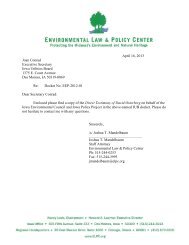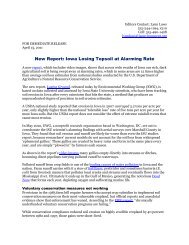Testimony of Tom Wind, Wind Energy Consulting, PC, Jamaica, Iowa
Testimony of Tom Wind, Wind Energy Consulting, PC, Jamaica, Iowa
Testimony of Tom Wind, Wind Energy Consulting, PC, Jamaica, Iowa
Create successful ePaper yourself
Turn your PDF publications into a flip-book with our unique Google optimized e-Paper software.
1<br />
2<br />
3<br />
4<br />
would provide transparency. Likewise, MidAmerican has mentioned that they are<br />
considering the addition <strong>of</strong> new nuclear generation or gas-fired combined cycle<br />
generation. If MidAmerican commits to either <strong>of</strong> these options, then its avoided costs<br />
should then reflect the cost <strong>of</strong> this new generation,<br />
5<br />
6<br />
7<br />
8<br />
9<br />
10<br />
11<br />
12<br />
13<br />
14<br />
15<br />
Q. Should the avoided cost for QF generation include additional charges representing<br />
distribution and transmission system costs?<br />
A. Yes, the avoided costs should include additional amounts that, at the minimum, represent<br />
the average transmission and distribution system loss that MidAmerican experiences on<br />
its system because the addition <strong>of</strong> QF generation, especially in amounts <strong>of</strong> 100 kW or<br />
less, almost always reduces both transmission and distribution losses. There will be a few<br />
locations where MidAmerican has large amounts <strong>of</strong> wind generation where the<br />
transmission losses may not be reduced with the addition <strong>of</strong> a QF. However, simply<br />
using the average transmission and distribution losses on MidAmerican’s system would<br />
be a reasonable and fair assumption.<br />
16<br />
17<br />
18<br />
19<br />
20<br />
21<br />
22<br />
23<br />
Q. EL<strong>PC</strong> and IEC have also stated that the avoided cost calculations should be fair and<br />
should result in rates that are sufficient to encourage cogeneration and small power<br />
production. How would you determine if the avoided costs are fair?<br />
A. The avoided costs would be fair if they truly represent the costs <strong>of</strong> MidAmerican’s<br />
additional generation or purchases to serve additional load. Since MidAmerican has been<br />
heavily investing in new wind generation, the avoided costs should be representative <strong>of</strong><br />
what MidAmerican’s customers will be paying MidAmerican through their rates for that<br />
11





